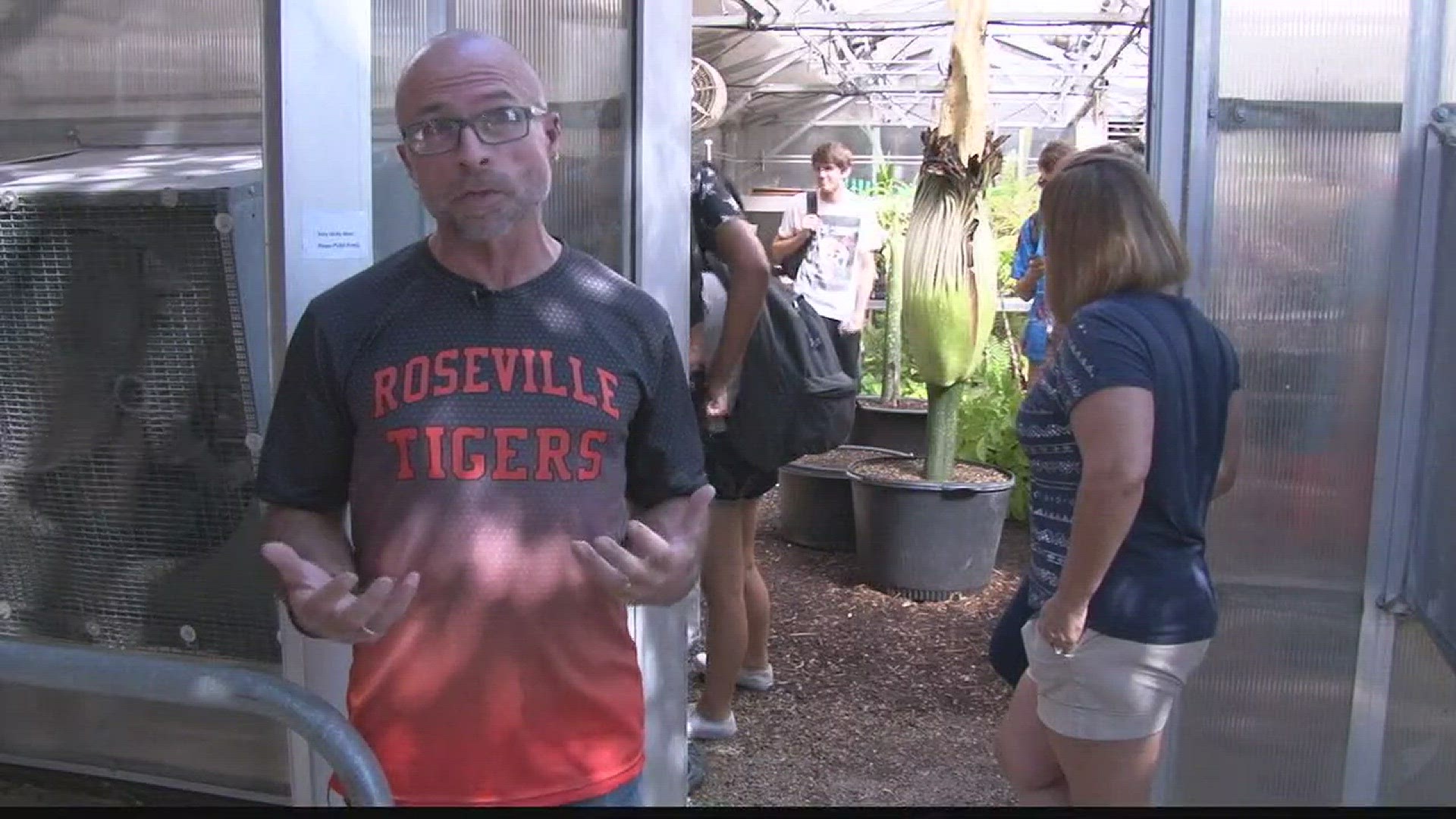It stinks. It's rare. And it takes a full decade to grow a flower that blooms for just 24 hours. At least, that's what's supposed to happen.
We're talking about the rare corpse flower.
Roseville High School science teacher CJ Addington spent the last 10 years nurturing one, only to have something go sadly wrong.
On Tuesday, however, he made the best of a bad situation and turned a disappointment into a learning opportunity for his students.
Standing just outside Roseville High School's greenhouse, Addington gestured to a monolithic green column dominating the space - and the attention - in the room.
"What we are seeing here is a very rare plant. It's called a corpse flower, or the scientific name would be a titan arum," Addington explained. "It's a giant flowering bulb from Indonesia. It takes about 10 years to get one to flowering size."
This isn't Roseville High's first corpse flower.
"We bloomed one in 2011, which was just a little guy: 3 feet. It's still a big flower," he said.
The one standing behind him on Tuesday afternoon, however, towered above the crowd at 6'3".
This giant plant, unlike its half-sized 2011 predecessor, did not open on time.
Dubbed Corona because of its predicted blooming date's proximity to the solar eclipse, the flower was supposed to open on or about Aug. 17. When that day - and several others - passed and the flower started looking a little worse for the wear, Addington reached out to experts at UC Davis, where he bought this plant's bulb 10 years ago.
"Unfortunately, we did have an issue with our lighting," Addington said. "There's a huge security light right above the greenhouse, shining on the flower...What we think happened is, it just fooled the plant into thinking that it was always daytime, and so it's a night bloomer. It was waiting for the night to come, and it never came."
The plant never bloomed and even started deteriorating, and Addington made a decision he executed on Tuesday.
"It didn't actually open, which is why we are now, today, going to manually open the flower," he said.
With a large knife, he cut open the plant, exposing its inner structure to the excited crowd of several dozen people.
"This whole thing is actually not one flower," he explained, pointing toward the base of the plant. "There's...hundreds of little male and female flowers inside."
The long, yellow structure forming the middle of the plant is called the spadix and is what generates the stinky odor for which the flower is named.
That smell was noticeably absent on Tuesday.
"If it had bloomed naturally, it would've given off a much, much stronger odor," Addington said. "This is a bit faded."
Luis Elumba is a senior at Roseville High School and one of Mr. Addington's students. On Tuesday, he was snapping photos of the flower with his Nikon camera for Yearbook - and for his teacher.
"It's important to document not just because of how rare of it but because of the effort that Mr. Addington put into the flower," he said. "The fact that he's been working on it for a decade kind of hits you a little bit harder, but at least he got it this far."
"I mean, yes, I was sad," Addington admitted. "It's like, 'Wow, I grew this thing for 10 years and it didn't open.' But, it was fun and I enjoyed it, and I have two more, so I'm not really going to be, like, too upset about it. And I have to remind myself that, at the end of the day, it's just a plant, so I can grow another one."
Two other corpse flowers live in the Roseville High greenhouse. They're set to bloom within the next year or two.
To the best of his knowledge, Addington said, Roseville High School is the world's only high school to ever grow a corpse flower.
"There are other people who grow these, but usually it's large universities and big botanical gardens, you know, like UC Davis, UC Berkeley, National Botanical Garden in D.C. Places like that," he said. "The fact that we're, like, a local, public high school and we grow them is actually pretty interesting."
Raising a corpse flower requires daily water, in addition to accommodating its growing size.
"It's a bulb, and what it does is, it grows a big leaf, and then it makes the bulb bigger. That leaf dies. You re-pot it," Addington explained. "Makes another leaf. That dies. You re-pot it. And it takes about 10 years to get it up to full size."
Once a bulb has produced a flower, however, another one can grow within about three years, so students at Roseville High School will not have to wait another decade before the one on display Tuesday produces a bloom.
"They're colorful, they're interesting, there's so much stuff going on in there," Addington said.

